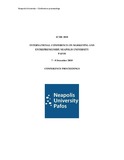| dc.contributor.author | Fotiadis, Thomas A. | |
| dc.contributor.author | Anastasiadou, Sofia D. | |
| dc.date.accessioned | 2019-01-18T11:04:16Z | |
| dc.date.available | 2019-01-18T11:04:16Z | |
| dc.date.issued | 2018 | |
| dc.identifier.uri | http://hdl.handle.net/11728/11303 | |
| dc.description.abstract | Even though there is a substantial development and utilization of pattering methods in the science of marketing, a direct comparison of multivariate methods in group/cluster identification in the field of Consumer Behavior has not been carried out.
Objective: This study analyses two different statistical techniques: i.e the Principal Components Analysis (PCA) and the Implicative Statistical Analysis (ASI). The main objective is to compare patterns derived from Principal Components Analysis (PCA) and Implicative Statistical Analysis (ASI) procedures with respect to Consumer Behavior.
Design: A survey was carried out using a structured questionnaire for a sample of 335 adults, customers of 125 Greek e-shops. These were conventionally approached by the Marketing Laboratory of a major public University in Northern Greece. Information Seeking, Information Sharing, Responsible Behavior subscales are related to Customer Participation Behavior. These subscales were measured by 15 items, rated on a seven-point Likert format, ranging from 1 (strongly disagree) to 7 (strongly agree).
Methods: The study focuses on the presentation of the two main types of clustering methods, Implicative Statistical Analysis (ΑSI) and Principal Components Analysis (PCA).
Results: PCA’s results showed the existence of 3 Component, amongst which the first is shown to be the Component of Responsible Behavior, the second is shown to be the Component of Information Sharing, and the third is shown to be the Component of Information Seeking.
ASI results release a similarity tree and a cohesive tree. Similarity tree showed that Information Seeking is the par excellence most powerful constituent of the creation of Customer Participation behaviour values and Information Sharing is the next similarity tree also showed that customers’ Responsible Behaviour is the weakest constituent for the creation of Customer Participation Behaviour values.
Hierarchical group of the items in conceptual construct Information Seeking exhibits the externally significant cohesion. Beliefs on conceptual construct Information Sharing imply beliefs on Responsible Behavior with exceptionally high cohesion. | en_UK |
| dc.language.iso | en | en_UK |
| dc.publisher | Neapolis University Paphos | en_UK |
| dc.relation.ispartofseries | 1st International Conference on Marketing and entrepreneurship, Neapolis University Paphos (ICME 2018), Conference Proceedings;7-8 December 2018 | |
| dc.rights.uri | http://creativecommons.org/licenses/by-nc-nd/4.0/ | en_UK |
| dc.subject | Principal Components Analysis | en_UK |
| dc.subject | Implicative Statistical Analysis | en_UK |
| dc.subject | Consumer Behavior | en_UK |
| dc.title | Contemporary advanced statistical methods for the science of marketing: Implicative Statistical Analysis vs Principal Components Analysis | en_UK |
| dc.type | Working Paper | en_UK |


